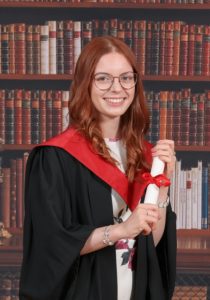
Disability Inclusion Student Ambassador Siobhan Smith writes about accessibility in higher education and what we all can think about to make Edinburgh Napier a more accessible place to study and work:
Higher education should be available to anyone who would like to access it. Unfortunately, this isn’t always the case for a variety of reasons.
For disabled people, there are many physical barriers. These barriers are often overlooked, sometimes because of the financial implications of removing them, sometimes because of the efforts it would take to remove them however, all too frequently they are overlooked due to people not knowing they are there.
As a wheelchair user, I find myself frequently being told by those nearest and dearest to me that a location is wheelchair accessible… only to get there and find some stairs. I have even done it to myself! I will be returning to a place I last visited before I used a wheelchair and have no recollection that there was in fact an entire mountain of stairs to climb to get inside.
Unfortunately, many access barriers require systemic or industrial changes (which is a topic for another day!) but thankfully, there are some that we can all play a part in removing.
Accessibility isn’t something everyone has to think of, and when it isn’t on your mind then you often won’t notice barriers are there. Accessibility shouldn’t only be on the minds of those who are facing barriers, it should be important to everyone.
Through educating ourselves on what these barriers might be, keeping an eye out for them and then bringing what we see to someone within the Disability and Inclusion team, each and every one of us can be doing something to make higher education just that little bit more inclusive.
We are so lucky here at Napier University to have such an incredible Disability and Inclusion team, they advocate for each and every one of you reading this, often without you even knowing. Find their contact information here: https://my.napier.ac.uk/wellbeing-support-and-inclusion/disability-inclusion/school-disability-contacts
So…what sort of things can you be looking for? (Staff and students alike)
• Signs that are difficult to read. Is the font too small? is it scribbly or uneven?
• Doors that are heavy, narrow, or seem like they should be electric but are not.
• Classrooms that are tightly packed.
• Unclean bathrooms
• Empty toilet paper, soap or hand towel dispensers.
• Red emergency pull cords that are tangled, broken or not reaching the floor.
• Lights that are out of order, or rooms with poor lighting.
• Moodle pages that somewhat resemble a maze.
• Are there subtitles or a transcript with videos that are part of your course?
These are just a few of the things we can all be looking out for. If you have taken the time to read to the bottom of this, why not take a little extra and research what makes for good accessibility? Next time you are making a presentation, doing group work, or planning an event, keep in mind the need to make everything as accessible as possible to as many people as possible.
Leave a Reply